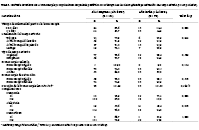Association between pre-bronchoscopy time of illness and post-bronchoscopy discharge time in pediatric patients with foreign body aspiration: retrospective cohort study in a Peruvian referral center, 2014-2019
DOI:
https://doi.org/10.17843/rpmesp.2023.404.12977Keywords:
Respiratory Aspiration, Airway Management, Pediatrics, Hospitalization, PeruAbstract
Objective. To determine the association between pre-bronchoscopy time of illness and post-bronchoscopy discharge time in pediatric patients with foreign body aspiration. Materials and methods. Retrospective cohort study. Medical records were studied and reviewed at the Pediatric Emergency Hospital of Lima, Peru. We reviewed 324 medical records, and selected 183 because they had the diagnosis of foreign body aspiration and complete data. Fisher’s exact test and Mann Whitney U test were used for the bivariate analysis, while Poisson regression was used to calculate the Relative Risk (RR) and its 95% confidence interval (CI). Results. We included 183 patients, of whom 65.6% were men with a mean age of 2.4 years. The most frequent location of the foreign body was the right bronchial tree and most of them were made of organic material. The majority (72.7%) of patients were discharged before 24 hours. We found an association between the time of illness prior to bronchoscopy and post-bronchoscopy discharge time (RR: 2.94, 95%CI: 1.72 – 5.01). Conclusions. The time of illness prior to bronchoscopy and the length of hospital stay after removal of the foreign body were significantly associated when adjusted for age, sex, type of foreign body and mouth sweep maneuver as a rescue measure. Our findings are relevant because they highlight the importance of early care, timely diagnosis and early management of pediatric patients.
Downloads
References
Sjogren PP, Mills TJ, Pollak AD, Muntz HR, Meier JD, Grimmer JF. Predictors of complicated airway foreign body extraction. Laryngoscope. 2018;128(2):490–5. doi: 10.1002/lary.26814.
Joao AB, Bueno FG. Foreign body aspiration in children. Pediatric Respiratory Reviews. 2002;3(4):303-7. doi: 10.1016/S1526-0542(02)00265-8.
Yanowsky-Reyes G, Aguirre-Jauregui OM, Trujillo Ponce SA, Rodriguez Franco E, Monroy Martín Y, Pérez Liñán JA, et al. Ingestión de sustencias químicas en esófago, análisis de las complciaciones tempranas y tardias en el manejo de los mismos, una revisión de 70 casos. iMedPub. 2013;9(2):1–7. doi: 10.3823/092.
Gómez Cervantes M, de la Torre Ramos CA, Jiménez Gómez J, Encinas Hernández JL, Hernández Oliveros F, Dore Reyes M, et al. Sospecha de aspiración de cuerpos extraños en pacientes pediátricos: Nuestra experiencia en 10 años. Cir Pediatr. 2018;31(2):81–4.
Cassol V, Marques Pereira A, Zorxela L, Michelin Becker M, Menna Barreto SS. Foreign body in children-s airways. J Pneumologia. 2003;29(3):139-44. doi: 10.1590/S0102-358620030000300005.
Tomaske M, Gerber AC, Weiss M. Anesthesia and periinterventional morbidity of rigid bronchoscopy for tracheobronchial foreign body diagnosis and removal. Paediatr Anaesth. 2006;16(2):123–9. doi: 10.1111/j.1460-9592.2005.01714.x.
Xu Y, Ren HB, Jiang L, Wang SF, Feng RL, Li Q. Analysis of related factors for the retention time of tracheobronchial foreign bodies in pediatrics. J Surg Res. 2019;233(72):262–7. doi: 10.1016/j.jss.2018.08.024.
Hidaka H, Obara T, Kuriyama S, Kurosawa S, Katori Y, Kobayashi T. Logistic regression analysis of risk factors for prolonged pulmonary recovery in children from aspirated foreign body. Int J Pediatr Otorhinolaryngol. 2013;77(10):1677–82. doi: 10.1016/j.ijporl/2013.07.024.
Suzen A, Karakus SC, Erturk N. The role of flexible bronchoscopy accomplished through a laryngeal mask airway in the treatment of tracheobronchial foreign bodies in children. Int J Pediatr Otorhinolaryngol. 2019; 117:194–7. doi: 10.1016/j.ijporl.2018.12.006.
Llanos Zavalaga L, Orellana Vasquez A, Aguado Taquire HF. Evaluación inicial del Sistena de Referencia y Contrareferencia ambulatoria en la DIRIS Lima Norte. Rev Med Hered. 2021;32(2):91-102. doi: 10.20453/rmvh.v32i3.3982.
Organización Mundial de la Salud. Módulos Nuevos [Internet]. OMS; 2018 [citado el 5 de septiembre de 2023]. Disponible en: https://www.paho.org/es/documentos/oms-programa-orientacion-salud-adolescente-para-proveedores-salud.
Hospital de Emergencias Pediátricas [Internet]. Lima: HEP; 2023 [citado el 5 de septiembre de 2023]. Disponible en: http://www.hep.gob.pe.
Liu B, Ding F, An Y, Li Y, Pan Z, Wang G, et al. Occult foreign body aspirations in pediatric patients: 20-years of experience. BMC Pulm Med. 2020;20(1):320. doi: 10.1186/s12890-020-01356-8.
Chung MK, Jeong HS, Ahn KM, Park SH, Cho JK, Son YI, et al. Pulmonary recovery after rigid bronchoscopic retrieval of airway foreign body. Laryngoscope. 2007;117(2):303-7. doi: 10.1097/01.mlg.0000250788.93900.ef.
Cevik M, Gókdemir MT, Boleken ME, Sogut O, Kurkcuoglu C. The characteristics and outcomes of foreign body ingestion and aspiration in children due to lodged foreign body in the aerodigestive tract. Pediatr Emerg Care. 2013;29(1):53-7. doi: 10.1097/PEC.0b013e31827b5374.
Zhong B, Sun SL, Du JT, Deng D, Liu F, Liu YF, et al. Risk factors for lower respiratory tract infection in children with tracheobronchial foreign body aspiration. Medicine (Baltimore). 2019;98(10):e14655. doi:10.1097/MD.0000000000014655.
Göktas O, Snidero S, Jahnke V, Passali D, Gregori D. Foreign body aspiration in children: Field report of a German hospital. Pediatr Int. 2010;52:100-3. doi: 10.1111.j.1442-200X.2009.02913.x.
Boufersaoui A, Smati L, Benhalla KN, Boukari R, Smail S, Anik K, et al. Foreign body aspiration in children: Experience from 2624 patients. Int J Pediatr Otorhinolaryngol. 2014;77(10):1683-8. doi: 10.1016/j/ijporl/2013.07.026.
Shlizerman L, Mazzawi S, Rakover Y, Ashkenazi D. Foreign body aspiration in children: the effects of delayed diagnosis. Am J Otolaryngol. 2010; 31:320-24. doi: 10.1016/j.amjoto/2009.03.007.
He S, Zuo ZL. Different anatomical sites of the foreign body injury with 2999 children during 2012-2016. Chin J Traumatol. 2018;21(6):333-337. doi: 10.1016/j.cjtee.2018.07.004.
Antón-Pacheco JL, Martín-Alelú R, López M, Morante R, Merino-Mateo L, Barrero S, et al. Foreign body aspiration in children: Treatment timing and related complications. Int J Pediatr Otorhinolaryngol. 2021;15(5)144:110690. doi: 10.1016/j.ijporl.2021.110690.
Pan H, Lu Y, Shi L, Pan X, Li L, Wu Z. Similarities and differences in aspirated tracheobronchial foreign bodies in patients under the age of 3 years. Int J Pediatr Otorhinolaryngol. 2012;16(4):911-4. doi: 10.1016/j.ijporl/2012.02.002.
Cutorone C, Pedruzzi B, Tava G, Emanuelli E, Barion U, Fischetto D, et al. The complimentary role of diagnostic and therapeutic endoscopy in foreign body aspiration in children. Int J Ped Otorhinolaryngol. 2012;75(12):1481–5. doi: 10.1016/j/ijporl/2011.08.014.
Sih T, Bunnag C, Ballali S, Lauriello M, Bellussi L. Nuts and seed: a natural yet dangerous foreign body. Int J Pediatr Otorhinolaryngol. 2012;14(76):S49-52. doi: 10.1016/j.ijporl.2012.02.012.
Chung MK, Jeong HS, Ahn KM, Park SH, Cho JK, Son YI, et al. Pulmonary recovery after rigid bronchoscopic retrieval of airway foreign body. Laryngoscope. 2007;117(2):303-7. doi: 10.1097/01.mlg.0000250788.93900.ef.
Nguyen DK, Friedlander S, Fleischman RJ, Zangwill KM. Length of Stay and Complications Associated with Febrile Infants <90 Days of Age Hospitalized in the United States, 2000-2012. Hosp Pediatr. 2018;8(12):746-752. doi: 10.1542/hpeds.2018-0132.
Rance A, Mittaine M, Michelet M, Martin Blondel A, Labouret G. Delayed diagnosis of foreign body aspiration in children. Arch Pediatr. 2022;29(6):424-428. doi: 10.1016/j.arcped.2022.05.006.
Johnson K, Linnaus M, Notrica D. Airway foreign bodies in pediatric patients: anatomic location of foreign body affects complications and outcomes. Pediatr Surg Int. 2017;33(1):59-64. doi: 10.1007/s00383-016-3988-9.

Downloads
Published
Issue
Section
License
Copyright (c) 2023 Esteban Andrés Huarhua Jimenez, Alejandro Kruchinsky Lozada, Marcelo Galdos Bejar, Nilton Yhuri Carreazo

This work is licensed under a Creative Commons Attribution 4.0 International License.




























